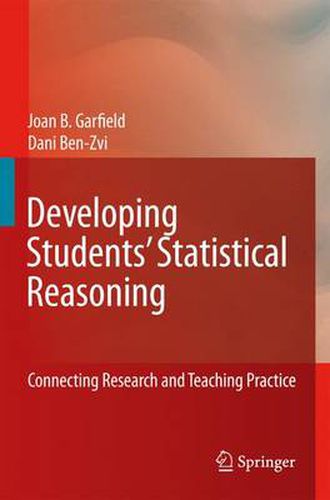Readings Newsletter
Become a Readings Member to make your shopping experience even easier.
Sign in or sign up for free!
You’re not far away from qualifying for FREE standard shipping within Australia
You’ve qualified for FREE standard shipping within Australia
The cart is loading…






This title is printed to order. This book may have been self-published. If so, we cannot guarantee the quality of the content. In the main most books will have gone through the editing process however some may not. We therefore suggest that you be aware of this before ordering this book. If in doubt check either the author or publisher’s details as we are unable to accept any returns unless they are faulty. Please contact us if you have any questions.
Increased attention is being paid to the need for statistically educated citizens: statistics is now included in the K-12 mathematics curriculum, increasing numbers of students are taking courses in high school, and introductory statistics courses are required in college. However, increasing the amount of instruction is not sufficient to prepare statistically literate citizens. A major change is needed in how statistics is taught. To bring about this change, three dimensions of teacher knowledge need to be addressed: their knowledge of statistical content, their pedagogical knowledge, and their statistical-pedagogical knowledge, i.e., their specific knowledge about how to teach statistics. This book is written for mathematics and statistics educators and researchers. It summarizes the research and highlights the important concepts for teachers to emphasize, and shows the interrelationships among concepts. It makes specific suggestions regarding how to build classroom activities, integrate technological tools, and assess students’ learning.
This is a unique book. While providing a wealth of examples through lessons and data sets, it is also the best attempt by members of our profession to integrate suggestions from research findings with statistics concepts and pedagogy. The book’s message about the importance of listening to research is loud and clear, as is its message about alternative ways of teaching statistics. This book will impact instructors, giving them pause to consider: Is what I’m doing now really the best thing for my students? What could I do better?
J. Michael Shaughnessy, Professor, Dept of Mathematical Sciences, Portland State University, USA
This is a much-needed text for linking research and practice in teaching statistics. The authors have provided a comprehensive overview of the current state-of-the-art in statistics education research. The insights they have gleaned from the literature should be tremendously helpful for those involved in teaching and researching introductory courses.
Randall E. Groth, Assistant Professor of Mathematics Education, Salisbury University, USA
$9.00 standard shipping within Australia
FREE standard shipping within Australia for orders over $100.00
Express & International shipping calculated at checkout
This title is printed to order. This book may have been self-published. If so, we cannot guarantee the quality of the content. In the main most books will have gone through the editing process however some may not. We therefore suggest that you be aware of this before ordering this book. If in doubt check either the author or publisher’s details as we are unable to accept any returns unless they are faulty. Please contact us if you have any questions.
Increased attention is being paid to the need for statistically educated citizens: statistics is now included in the K-12 mathematics curriculum, increasing numbers of students are taking courses in high school, and introductory statistics courses are required in college. However, increasing the amount of instruction is not sufficient to prepare statistically literate citizens. A major change is needed in how statistics is taught. To bring about this change, three dimensions of teacher knowledge need to be addressed: their knowledge of statistical content, their pedagogical knowledge, and their statistical-pedagogical knowledge, i.e., their specific knowledge about how to teach statistics. This book is written for mathematics and statistics educators and researchers. It summarizes the research and highlights the important concepts for teachers to emphasize, and shows the interrelationships among concepts. It makes specific suggestions regarding how to build classroom activities, integrate technological tools, and assess students’ learning.
This is a unique book. While providing a wealth of examples through lessons and data sets, it is also the best attempt by members of our profession to integrate suggestions from research findings with statistics concepts and pedagogy. The book’s message about the importance of listening to research is loud and clear, as is its message about alternative ways of teaching statistics. This book will impact instructors, giving them pause to consider: Is what I’m doing now really the best thing for my students? What could I do better?
J. Michael Shaughnessy, Professor, Dept of Mathematical Sciences, Portland State University, USA
This is a much-needed text for linking research and practice in teaching statistics. The authors have provided a comprehensive overview of the current state-of-the-art in statistics education research. The insights they have gleaned from the literature should be tremendously helpful for those involved in teaching and researching introductory courses.
Randall E. Groth, Assistant Professor of Mathematics Education, Salisbury University, USA